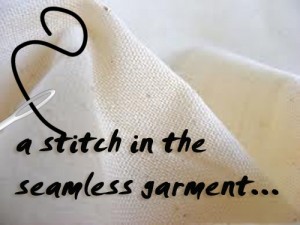Adding a Stitch in the Seamless Garment of Life
 Many of you probably read the recent heartbreaking news of Marc and Eddy, deaf twins who requested, and were granted, euthanization in Belgium after discovering they were going blind.Later this year, Belgium’s ruling party is set to consider allowing the euthanasia of children and Alzheimer’s sufferers.
Many of you probably read the recent heartbreaking news of Marc and Eddy, deaf twins who requested, and were granted, euthanization in Belgium after discovering they were going blind.Later this year, Belgium’s ruling party is set to consider allowing the euthanasia of children and Alzheimer’s sufferers.
This news was on my mind recently when I read about Robert Gleason, an inmate in Virginia, who was executed last week. He wanted the death penalty so badly that he killed other inmates so he would receive it.
It struck me that the United States is already helping perfectly healthy people commit suicide. It just seems there isn’t as much of an uproar about it because they are criminals.
If we stop to think about life issues, it is shocking how delicately each issue is woven into another. When one suffers, they all suffer.Slowly but surely the “seamless garment” of life in our culture is being torn apart.The phrase “seamless garment” was first used in connection with the interrelatedness of all life issues by Roman Catholic pacifist Eileen Egan. And Cardinal Bernardin picked up this line of thought when he developed the Consistent Ethic of Life in 1983. The words “seamless garment” are drawn from the Gospel of John, when, at the crucifixion, the soldiers cast lots for the clothing Jesus had been wearing: “the tunic was seamless, woven in one piece from the top down” (Jn 19:24).
Unfortunately, the “seamless garment” approach has gotten a bad rap because it has been misused by Catholics who focus on some life issues but reject or downplay the most important life issue of our times: abortion.
But just because something is misused does not mean we should cease using it, (we would have to stop reading the Bible real fast if we lived by that logic).
Life is a seamless garment, a garment that originates in the hands of God. The garment of Jesus itself was woven with materials found in the natural world, created by God. Mary, the mother of Jesus, is the person who most likely wove the seamless garment. For me, this represents the important role that we, as humans, have to play in maintaining and protecting the seamless garment of life.
So here is the practical, everyday application of the “seamless garment” philosophy in my mind:
We can go to the March for Life. We can minister to prisoners. We can picket for religious freedom. We can postbrilliant and hilarious blog posts on life issues. We can do all these things and more – and they are important.But we can also do something even more concrete, every single day.Anytime we love others with the extravagant, unconditional love, that mirrors God’s love, we are putting another stitch in the seamless garment of life, and bolstering the fabric of human dignity. We do this simply by showing others how important they are and how precious their life is.Loving others is one of the most important aspects of truly respecting life – one that we all manage to neglect quite often, (as is evident by the ongoing online discussions about disrespect among Christians online).
This sounds simple, but I believe that in its simplicity lies a key but oft overlooked truth. Our tireless work to promote respect for human life is made meaningless if we do not practice it in the everyday interactions of our lives.While others tear it asunder, we can add another stitch in the seamless garment of life – practically, every single day – by respecting those around us and deeply loving them into believing that their life and all life is precious.

